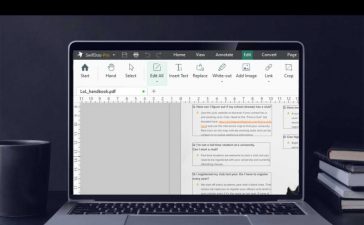After announcing its Microsoft 365 Copilot chatbot to automate various tasks in multiple Microsoft office apps, Microsoft on Thursday demonstrated the tool’s capabilities and introduced a new extension called Business Chat.
Microsoft 365 Copilot is generative artificial intelligence (AI) technology based on GPT-4, a large language model (LLM) created by OpenAI, which is also the basis for the wildly popular ChatGPT chatbot.
The company said it is currently testing Microsoft 365 Copilot with 20 customers, including eight Fortune 500 enterprises, in order to “get feedback and improve our product as we scale.” It said it would provide additional details to customers about broader availability of the features at a future date.
Microsoft has integrated the GPT-4 and ChatGPT functionality with Word, Excel, Teams, PowerPoint, Outlook, Power Platform, Viva, and other apps to enable users to pull data together to create everything from marketing campaigns and business proposals to slide presentations.
Microsoft CEO Satya Nadella said the new 365 Copilot chatbot will “radically transform how computers help us think, plan and act.
“Just as we can’t imagine computing today without a keypad, mouse or multitouch, going forward we won’t be able to imagine computing without copilots and natural language prompts that intuitively help us with continuation, summarization, chain-of-thought reasoning, reviewing, modifying and acting,” he said.
Copilot combines a large language model (LLM) with the 365 suite and the user data contained therein. Through the use of a chatbot interface and natural language processing, users can ask questions of Copilot and receive human-like responses, summarize online chats, and generate business products.
Copilot in Word, for example, can jump-start the creative process by giving a user a first draft to edit and iterate on — saving hours in writing, sourcing, and editing time, Microsoft said in a blog post.
“Sometimes Copilot will be right, other times usefully wrong — but it will always put you further ahead,” Jared Spartaro, Microsoft’s corporate vice president of Modern Work & Business Applications, said in the blog. “You’re always in control as the author, driving your unique ideas forward, prompting Copilot to shorten, rewrite or give feedback.”
 Microsoft
MicrosoftAn example of Copilot in Word using meeting notes to create a draft proposal.
Microsoft claims Copilot is more than OpenAI’s ChatGPT embedded into Microsoft 365. Officials referred to it as a “sophisticated processing and orchestration engine” that combines the power of LLMs, “including GPT-4,” with the Microsoft 365 apps and a user’s business data in the Microsoft Graph, which is now accessible to everyone through natural language. (Microsoft Graph is the company’s API developer platform that connects multiple services and devices.)
Copilot in Microsoft’s new Business Chat feature, for example, can be used to create a summary of a chat conversation, pull out specific taking points, add recent contacts with customers, access entries in the Outlook calendar, and add slides from a presentation to create a business proposal — all based on the chat conversation.
Users of Business Chat can also write natural-language prompts, such as “Tell my team how we updated the product strategy,” and it will generate a status update based on the morning’s meetings, emails, and chat threads.
Copilot in PowerPoint can aid in creating presentations with a simple prompt, adding relevant content from a document a user may have made last week or last year. And Copilot in Excel can analyze trends and create professional-looking data visualizations in seconds.
“We all want to focus on the 20% of our work that really matters, but 80% of our time is consumed with busywork that bogs us down. Copilot lightens the load,” Spartaro said.
Copilot in Teams can summarize key discussion points, including who said what and where people are aligned and where they disagree, and it can suggest action items — all in real time during a meeting.
Because of Copilot’s intuitive AI-based capabilities, the chatbot allows users to take advantage of advanced functionality without the need for expertise in Microsoft 365 application use. “The average person uses less than 10% of what PowerPoint can do. Co-pilot unlocks the other 90%,” said Sumit Chauhan, corporate vice president of Microsoft’s Office Product Group.
 Microsoft
MicrosoftCopilot in PowerPoint turns ideas into presentations by creating textual content, images and video from multiple sources.
For example, someone working at a global manufacturing company who wants to create a customer proposal can ask Copilot to use customer notes in OneNote and other internal documents to quickly generate a first draft. It can then use the format typically used for proposals by pulling from a user’s history.
“It inserts product images and pulls in relevant visuals from other files. You can even include a short summary at the top of the document, and Copilot can make suggestions to strengthen the proposal — like adding an FAQ, which it will generate for you,” Chauhan said.
The integration of large language models (LLMs) with a user’s business data, including that stored in OneDrive (documents, photos and videos), allows for greater creativity without the painstaking work of pulling it all together yourself, according to Spartaro.
 Microsoft
MicrosoftCopilot in Excel works alongside users to help analyze and explore data.
Microsoft was candid that its chatbot will make mistakes, but it promised to address those issues “quickly.” Generative AI tech, such as that embedded in Microsoft’s Bing search engine or Google’s Bard chatbot service, has demonstrated glaring response errors. Chatbots also have issues with “hallucinations,” or going down a rabbit hole of bizarre content generation based on errors.
Microsoft said it is keenly aware of the privacy and security implications of generative AI engines, and it has vetted its product and will continue to monitor it closely.
“We not only built [data] grounding into the system, we built verification into the experience,” Spartaro said. “We added citations and introduced forms of friction to encourage back-and-forth collaboration [between the user and the Copilot]. We included feedback mechanisms so people can let us know when we get it wrong.
“Our goal is to give people agency. To help people get started, Copilot suggests good prompts. If you don’t like what it does, there’s the ‘try again’ button,” Spartaro said. “You always have the option to use, adjust, discard or undo.”
Copyright © 2023 IDG Communications, Inc.












